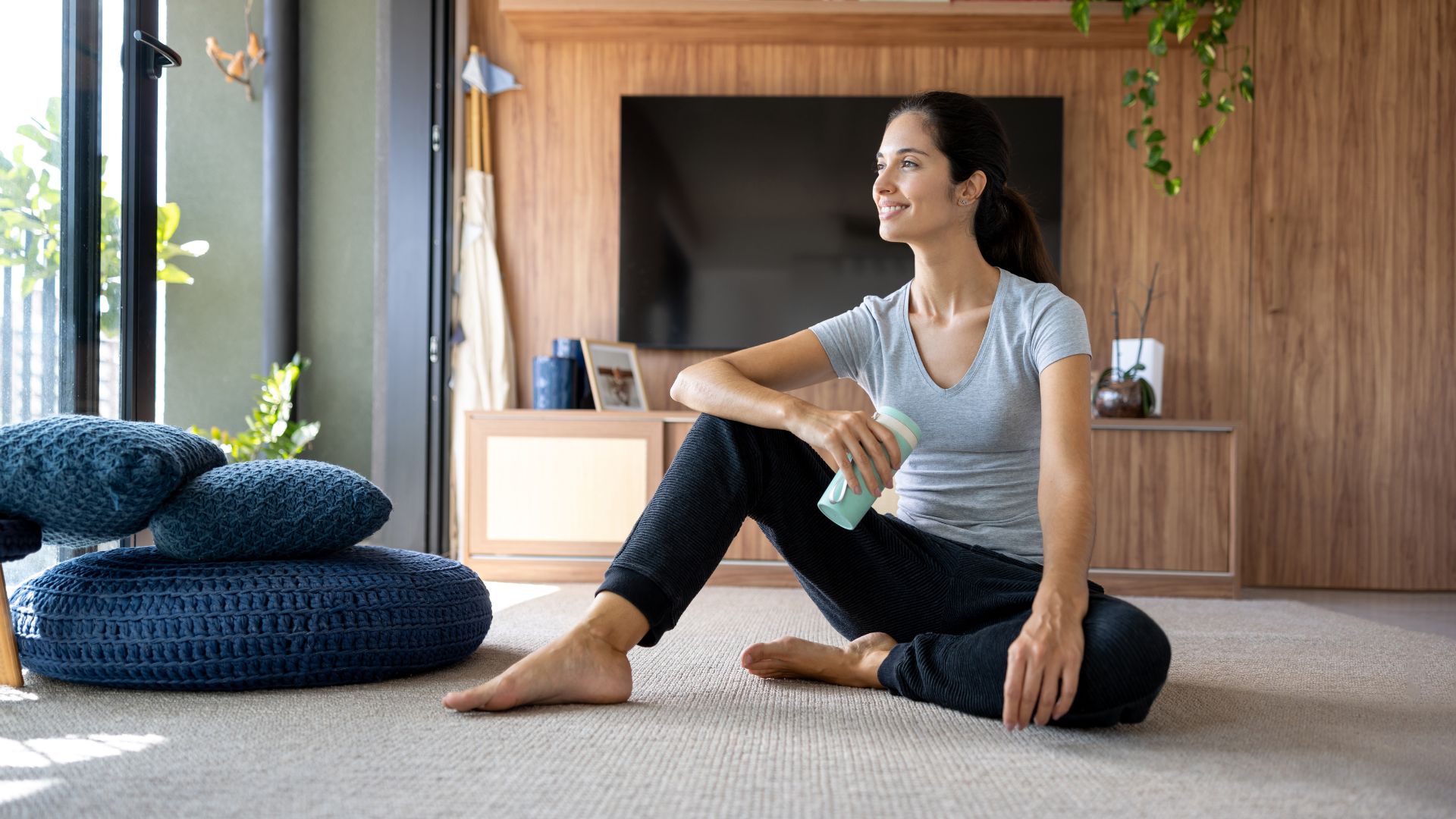Move over, squats - I'm doing the clamshell exercise for stronger glutes and hips now
The clamshell exercise is loved by physios and personal trainers alike for the gentle way it strengthens muscles and improves stability in the lower body


I love the clamshell exercise, too. I do this simple movement on the floor, from the comfort of my yoga mat (or carpet), and it's done more for my hip mobility, core stability, and glute (buttock) strength than many other weighted exercises.
The squat certainly has its place in a strength training routine. There's no denying this compound movement is a good one, strengthening multiple large muscle groups at once. But, it can be trying on the bones and joints, especially if you're newer to weighted exercise or coming back from an injury, like me.
The clamshell exercise is the perfect squat alternative. After dealing with so-called 'Runner's Knee', I started doing the clamshell exercise last year to get back to my routine of running and lifting weights. Four months down the line, here's why I'm keeping it in my home workouts...
What is the clamshell exercise?
The clamshell exercise is a Pilates-inspired move done lying on your side, hand tucked under your head and knees together. The name comes from the position of the knees, which open and close during the movement, engaging all the muscles in the glutes (buttocks), the hip flexors, and the core muscles.
"I particularly like them as they help build awareness of how we move, activating muscles we often overlook in more dynamic workouts," says Paola Di Lanzo, a personal trainer, Pilates instructor, and founder of Paola's Body Barre. "Done with control and breath, clamshells create a strong, stable foundation for the rest of your body to move freely and safely."
While it's easier in some ways than other lower-body exercises, I found the clamshell challenging when I first started doing it. It requires concentration to keep your hips, knees, and elbows in line without wobbling or toppling over.
However, once I got the hang of it, I started to see the benefits in just a couple of weeks. My glutes were the first to notice a difference, feeling stronger and looking perkier than they had in a while. The benefit for my hip stability came next, and now I'm back to running 10km or more every week, alongside regular strength and Pilates home workouts.
Sign up to our free daily email for the latest royal and entertainment news, interesting opinion, expert advice on styling and beauty trends, and no-nonsense guides to the health and wellness questions you want answered.
How to do the clamshell exercise
- Lie on your side with a thick yoga mat underneath you for support, if you need it.
- Prop your head up on your arm or use a pillow if that's more comfortable.
- Bring your knees in towards your chest, about 90 degrees.
- Stack your knees and hips on top of each other, keeping your knees and feet together.
- Take a breath in. "Don’t forget your breath," says Di Lanzo. "Holding your breath adds tension, especially in the neck and jaw."
- In a controlled way, lift your top knee towards the ceiling as high as you can, without rolling your hips back. Keep your feet together.
- Hold this position. "The aim should be to keep your hips stacked and your core gently engaged to isolate the glutes," says the Pilates instructor.
Expert tip: "Move slowly and focus on maintaining tension throughout," says Di Lanzo. "As with all Pilates moves, avoid rushing. It's not about how many reps you can do, but how connected you are to each one. Breath is key too. Exhale as you lift, inhale as you lower."
Benefits of the clamshell exercise
- Boosts glute strength: "Clamshells are an effective low-impact exercise that strengthens key stabilising muscles, especially the gluteus medius," says Di Lanzo. This is a muscle on the outside of the upper buttocks. It helps with most daily movements (like getting out of a chair) and workouts, especially walking and running, so keeping it strong is important.
- Improves hip stability: "This is vital for posture, balance, and injury prevention," says Di Lanzo. Stronger hips and better stability also mean less chance of tight hips, which can be uncomfortable, and contribute to a stronger pelvic floor.
- Reduces lower back pain: "Clamshells support better pelvic alignment by activating deep glute muscles, which can alleviate tension in the lower back and hips," says Di Lanzo.
- Helps with knee pain: "When your glute medius is underactive, your knees can collapse inwards during walking or squats, which in turn, places strain on the joint," says the PT. "Clamshells help strengthen the muscles that stabilise the hip and align the femur properly in the socket, reducing pressure on the knee."
- Useful for warming up before exercise: Even if you only do a couple of clamshells before your dumbbell workout at home, they can make a difference by helping to warm up the hips and glutes.
How to do a banded clamshell exercise
If you want to make your clamshell harder, add a resistance band and do a weighted clamshell. "Placed just above the knee, a band helps fire up the glute medius more effectively," says Di Lanzo. "The band also gives you real-time feedback, encouraging better form and preventing your top leg from lifting too high."
Here's how to do it:
- Come down onto your side in the traditional clamshell set-up, with your head on your arm or on a pillow.
- When your knees sit parallel to your hips, wrap a resistance band around your legs, just above the knee.
- Make sure your knees and hips stay stacked and your feet keep together.
- Bring your top leg up as high as you can.
- Hold the position for a moment, before gently coming back down.
Variations of the clamshell exercise
Reverse clamshell
As you might expect, the reverse clamshell is the regular clamshell, but instead of the knees moving away from each other, you keep them together and move the ankles away from each other.
This can help strengthen the hips and be a good stretch for tight hips to improve mobility.
Standing clamshell
Looking to improve your balance? Try a standing clamshell. You'll need a wall behind you and a resistance band, but it's one of the best stretches for runners as it focuses on one leg at a time.
Seated clamshell
A seated clamshell is very similar to a lying clamshell, the traditional move, except it's done sitting on a chair. This takes away some of the hip-stabilising and core-strengthening benefits, but it's still useful for building strength in the lower body and is good for anyone doing Pilates for beginners.
How many times should I do the clamshell exercise?
If you're new to the clamshell exercise, start with 10 repetitions on each side for two sets. This is 20 clamshells in total. If you can do these without changing your form and leaning back, you could do more or make them harder with a resistance band.
Most experts recommend weight training at least twice every week for stronger hips and glutes. You could include the clamshell exercise in these sessions or as part of a full-body resistance band workout.
If you're ever in doubt about the exercise, talk to a personal trainer or physiotherapist at your local studio or gym.

Grace Walsh is woman&home's Health Channel Editor, working across the areas of fitness, nutrition, sleep, mental health, relationships, and sex. She is also a qualified fitness instructor. In 2025, she will be taking on her third marathon in Brighton, completing her first ultra marathon, and qualifying as a certified personal trainer and nutrition coach.
A digital journalist with over seven years experience as a writer and editor for UK publications, Grace has covered (almost) everything in the world of health and wellbeing with bylines in Cosmopolitan, Red, The i Paper, GoodtoKnow, and more.



